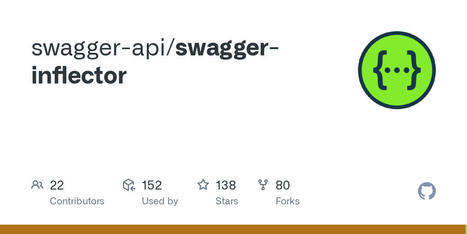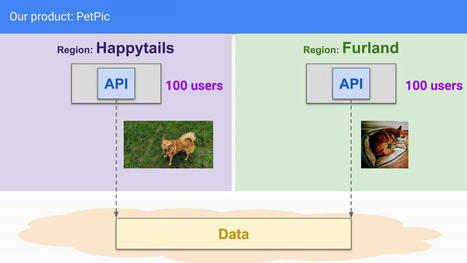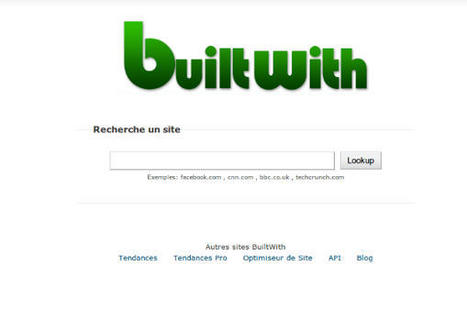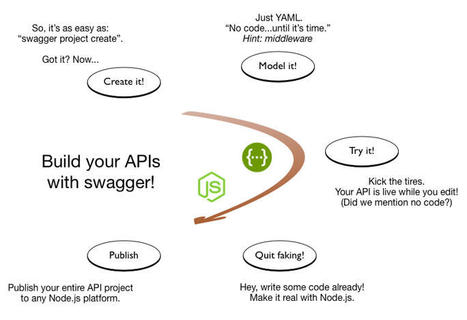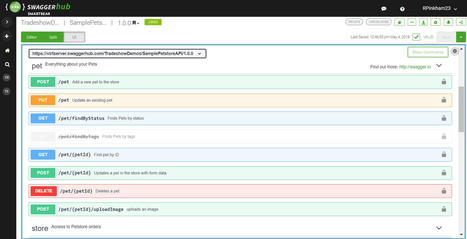 Your new post is loading...
 Your new post is loading...
API de la norme AFNOR XP Z 10-011 de mai 1997 du format d'adresse postale français. Interface et implementation de base en java - GitHub - amertum/adresse-postale: API de la norme AFNOR XP Z 10-011 de mai 1997 du format d'adresse postale français. Interface et implementation de base en java
A Transitional Year for Jamstack
According to Davis, Jamstack is constantly evolving and 2021 felt very much like a transitional year. He went on to warn about a current identity crisis with the Jamstack pattern. “With Next.js absolutely exploding in 2020, it brought into question what Jamstack really means,” he said. “The community led by Netlify evolved the definition to suit their product, while working to preserve the original benefits of Jamstack. It is still evolving in my mind. What is Jamstack became a difficult question for anyone to answer, and it's been the theme of 2021. Lots of people with lots of opinions out there.”
Davis' hope is that 2022 will see the architecture grow and mature a bit.
The flexibility of the REST arthropod allows developers to create an associated level API that meets your wishes as well as the wishes of very different customers.
Design, describe, and document your API on the first open source editor fully dedicated to OpenAPI-based APIs. The Swagger Editor is an easy way to get started with the OpenAPI Specification (formerly known as Swagger), with support for Swagger 2.0 and OpenAPI 3.0.
Contribute to swagger-api/swagger-inflector development by creating an account on GitHub.
In this tutorial, we explore how to design and implement a RESTful API using Java. After finishing, you should better understand the following topics:
Restful API Design,
implementing a REST API using Java,
documenting that REST API using Swagger,
and publishing your API on RapidAPI.
Understanding this tutorial requires at least a cursory understanding of Java and the following Java technologies:
JAX-RS 2.0,
Spring Boot,
JSON, and the
Jackson JSON library.
However, the tutorial does not presuppose an in-depth knowledge of these technologies.
Within the last decade, technologies like GraphQL have changed how we build web apps and how they communicate with each other. GraphQL provides certain benefits over REST APIs — let’s find out what they are.
The increasing importance of Google's Core Web Vital score increases the impact of third-party scripts on SEO rankings. Learn the best practices to stay on top!
A REST API is a type of API that adheres to REST limitations and allows interactions with other sites. Any page that follows REST constraints is informally called RESTful API. Below are some of its core features.
A RESTful API is stateless
It supports JSON and XML alike
It offers simplified implementation versus the standard SOAP
Every architectural modification in the REST API should reflect in its documentation
It provides developers with an extensive range of error messages
Here’s a REST API example in an e-commerce setting. If you want to purchase affordable running shoes, you use a search engine, type in keywords, and receive a list of options in return. In most cases, the results are relevant to your search. If used correctly, this tool should enhance a client’s experience with your brand.
Before you run tests, here are some guidelines to follow on how to create REST API:
Use HTTPS
Include a timestamp to requests
Limit HTTP methods
Apply input validation if necessary
Use OAuth
Avoid showing sensitive data on URLs
Découvrez pourquoi les développeurs devraient utiliser les avantages de Swagger et des spécifications OpenAPI pour rationaliser la conception, la documentation et la gestion des API en particulier des API RESTful.
Croyez à la puissance des API ! Votre entreprise a besoin de créer des solutions omnicanal, d'innover plus vite que la concurrence et de devenir une entreprise mobile ou de travailler dans un environnement de cloud hybride. Les API modernes vous permettent d'utiliser des écosystèmes ouverts et de nouveaux modèles économiques. Ce guide pratique vous explique comment utiliser les API pour le bénéfice de votre entreprise.
Considérez une API comme un produit : elle représente quelque chose que vous avez choisi de partager avec un public cible.
Testez tôt, apprenez vite et adaptez facilement : découvrez une approche expérimentale des API.
Utilisez toujours les API pour délimiter votre domaine : gardez un contrôle et une visibilité sur les trafics entrant et sortant.
Utilisez des plates-formes d'API spécialisées : simplifiez et sécurisez à 100 % le partage d'API.
More than five years ago, we launched the Slack Platform, giving developers an easy way to build apps in Slack and publish them in our App Directory. Today, millions of users bring their work into Slack, and those apps built by over 885,000 active developers on the platform are key to further improving collaboration in …
Silvia Esparrachiari nous explique comment un changement mineur peut impacter un système, et souligne l’importance d’en avoir une vision globale pour mieux comprendre l’impact d’une modification.
|
Voici une liste des services Web et d’extensions pour Google Chrome et Firefox permettant de savoir facilement quelles technologies, framework, CMS, bibliothèque (JavaScript, CSS, …), etc. utilise un site Web. « Chrome Sniffer » est une extension pour le navigateur Google Chrome qui permet de connaitre les frameworks et CMS (Joomla, WordPress, Drupal, …), service […]
A webhook is an API endpoint that serves a different purpose: instead of just being there to look up information like a typical GET API endpoint, we can POST to the webhook with some JSON data, and then it'll do something internally. That means webhooks can serve as a sort of event system. Using the same company analogy, if the API is like the team responding to inquiries from other parties, webhooks would be the team that takes action when an approved partner says it's time, like the team who updates the inventory when the supplier says they have more items in stock.
So basically, webhooks are like anti-API endpoints. They take in data and do internal work where regular API endpoints return data so that the client asking for that data can do something with it.
OK! So that probably answers your question, right? You found your way to this article trying to work out the difference between APIs and webhooks, and there it is, explained in two easy sentences. So are we done?
Didn't think so. You want to see this in practice... well alright then! Let's jump in.
Javascript library to connect to swagger-enabled APIs via browser or nodejs - GitHub - swagger-api/swagger-js: Javascript library to connect to swagger-enabled APIs via browser or nodejs
The swagger module provides tools for designing and building Swagger-compliant APIs entirely in Node.js. It integrates with popular Node.js servers, including Express, Hapi, Restify, and Sails, as well as any Connect-based middleware. With swagger, you can specify, build, and test your API from the very beginning, on your laptop. It allows you to change and iterate your design without rewriting the logic of your implementation. Remember, one great thing about this approach is that all of the Swagger validation logic is handled for you, and all of the routing logic is managed through the Swagger configuration. You don't have to code (or recode!) any of that stuff yourself.
Swagger UI allows anyone — be it your development team or your end consumers — to visualize and interact with the API’s resources without having any of the implementation logic in place. It’s automatically generated from your OpenAPI (formerly known as Swagger) Specification, with the visual documentation making it easy for back end implementation and client side consumption.
In this article, we will talk about the best technology of the interaction between software and test it on the most popular language for creating software This is a tough question so we'll divide it into a few parts
The Web Platform Incubator Community Group recently published the Draft Community Group Report for the HTML Sanitizer API. The HTML Sanitizer API lets developers take untrusted strings of HTML and sanitize those strings for safe insertion into a document’s DOM. The most common use case of HTML string sanitization is to prevent cross-site scripting (XSS) attacks.
Since the dot com boom, e-commerce has meant big business for all involved. If you are considering setting up your own e-commerce offering, there is a lot you need to consider. From SDKs and APIs to general architecture decisions, this Refcard will help you navigate those options.
Le test d’API RESTful insuffle au sein de l’entreprise une culture de tests en continu et d’une forme de responsabilité de l’équipe. Greg Sypolt passe en revue les composants clés d’un programme de test.
Google has a bunch of different APIs. It can be tricky to figure out how to incorporate them into a Django project. We just released a course on the freeCodeCamp.org YouTube channel that will teach you how to build a Django app that uses multiple Google APIs. Bobby Stearman
JavaScript est un langage de programmation qui vous permet de mettre en œuvre des éléments complexes sur des pages Web (une page Web contenant plus que de simples informations statiques). Chaque fois qu'une page affiche des mises à jour de contenu en temps réel, des cartes interactives, des animations graphiques 2D / 3D ou un juke-box vidéo défilant, etc. — vous pouvez parier que JavaScript est probablement impliqué.
What You Will Learn: [hide]
What Is Karate Framework
History Of Karate Framework
Comparing Karate Vs Rest-Assured
Tools Required For Working With Karate Framework
Structure Of Karate Test Script
Creating The First Basic Karate Test Script
Conclusion
Recommended Reading
|
 Your new post is loading...
Your new post is loading...
 Your new post is loading...
Your new post is loading...








